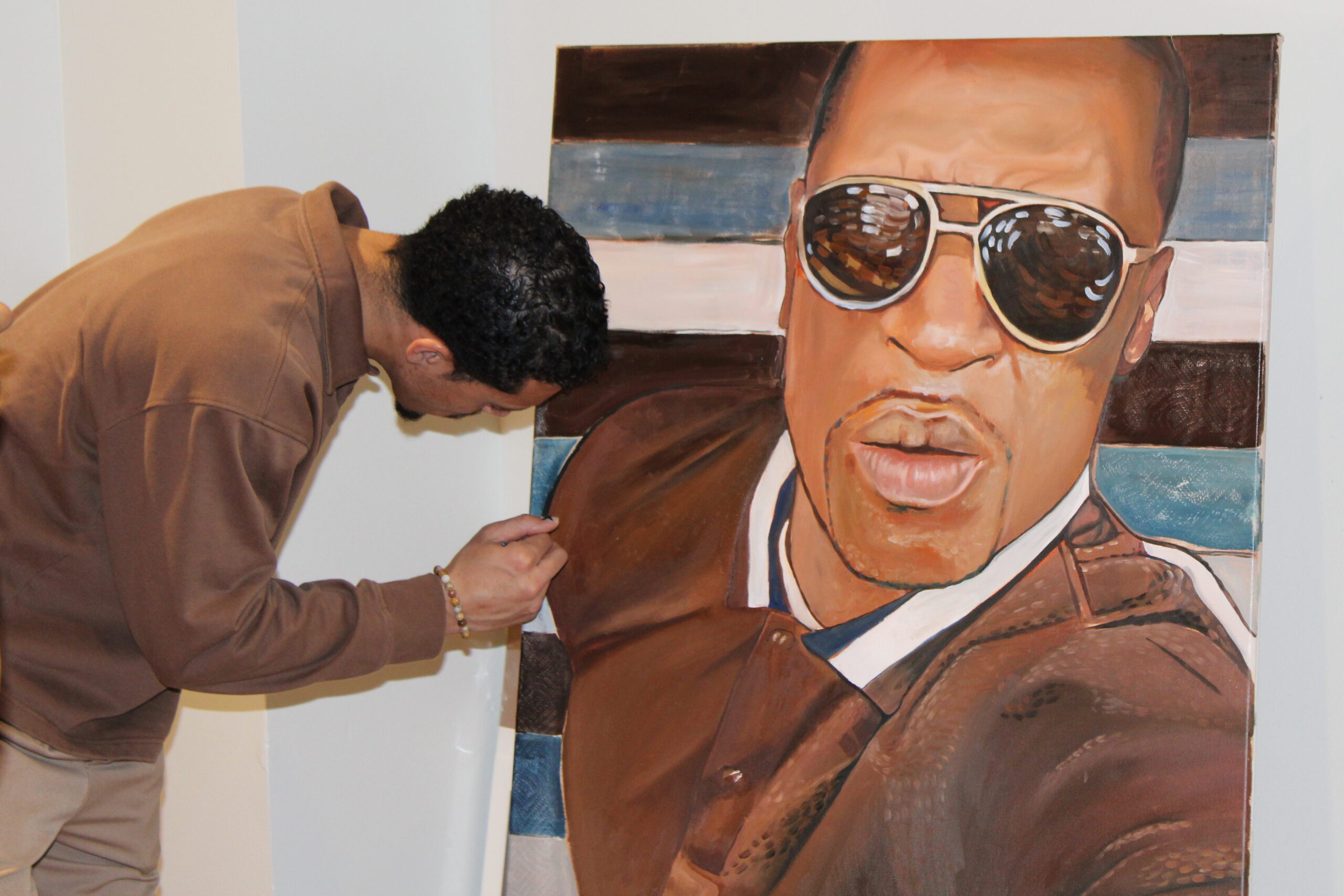Meet Shaylen: The Innovative Multidisciplinary Artist Transforming Collective Memory at Charlotta Bass Day

On this year’s Charlotta Bass Day, we were honored to feature a live painting performance by innovative multidisciplinary artist Shaylen Nelson, who helped us foster a restorative experience for George Floyd’s loved ones and event participants. Shalyen’s performance helped restore George’s humanity to his collective memory and media representation and commemorate his brother Philonise Floyd’s participation in our Voices of the Movement series.
**Shaylen’s answers were edited for concision and clarity.
Shifting Collective Memory & Dialogue
Shaylen’s artistic process is intentional and purpose-driven, indiscriminately exploring artistic styles and mediums to create cultural commentary and tell visual stories. Learn more about the event and Shaylen’s advocacy-informed artistic process:
Bass Lab: What was the decision process in selecting the selfie image of George Floyd referenced in your painting?
Shaylen Nelson: For the selfie image of George Floyd, it was vital that I had a unique image that stood out to create a truly one-of-one painting. Many artists have already used George Floyd’s iconic selfie, looking into the camera in his black hoodie. Understanding that this painting would be gifted to the Floyd family and the high probability that they’ve seen several inspired art pieces with the popular image of Floyd, I wanted the family to experience an artwork of him that was refreshing, in the hopes of my painting offering a new take on his life and legacy.
I intentionally asked if there was a specific image that the family would like me to create into a painting. The reference picture they sent was the specific one used for this artwork. It was one that, I think, perfectly conveyed him from an optimistic perspective, a spirited image of him in sunglasses while still conveying a confident pose. It embodies George Floyd, not merely as a victim of police brutality and racism, but as a human being with character and personality just like everyone else.
Bass Lab: How did you embody the themes of resistance, resilience, and remembrance in the artistic style you used to create this piece?
Shaylen Nelson: I embodied the themes of resistance, resilience, and remembrance mainly through the color palette I chose. The influence of color plays a huge role in how we interpret an art piece, and this George Floyd painting was no different. Sepia is a color and visual aesthetic that always had a timely feeling for me. Whenever we look back at history books of the civil rights movement, most of these pictures were either in black and white or in a sepia-aged color. I chose to depict George Floyd in this sepia color scheme to connect his legacy with the civil rights movement. It symbolically links this art piece to numerous moments of resilience and resistance from past revolutionaries and advocates that changed our country.
Bass Lab: As a live artist, how do you engage and process the real-time public dialogue your work sparks?
Shaylen Nelson: As a live artist, one way I engage and process the public dialogue about my work is simply by conversing with my viewers. I’ve always been motivated to speak out on social and racial issues within my art. My main goal in voicing these issues is to generate conversation and questions that society can discuss more. When dialogue comes from my work, I am eager to join the conversation to exchange thoughts, emotions, and ideas.
Bass Lab: In particular, on Charlotta Bass Day, you painted a remembrance for George Floyd’s loved ones (brother Philonise Floyd and sister-in-law Keeta Floyd). How did receiving feedback from those most connected to your subject impact your work?
Shaylen Nelson: Receiving feedback from the people so closely connected to George Floyd was such an honor for me. It made creating this art piece even more intimate with the family. Getting their reactions in real time and hearing them voice their thanks and gratitude felt like a full-circle moment from when I did my first art piece of George Floyd during the Black Lives Matter protests. Back then, I never expected George Floyd’s family to see my work, much less get to meet them. But the physical moments and interactions surrounding this latest painting only add to the weight, symbolism, and legacy it carries.

An Artist’s Role in Social Change
Shaylen has built a reputation in LA as an artist who motivates deeper introspection through community-centered art performances at cultural events hosted by WalkGoodLA, Taste of Soul Festival, Black Market Flea, and more. We explored Shaylen’s thoughts on art’s role in social change:
Bass Lab: The Second Draft Project aims to preserve history, shape the future, and uphold justice, equity, and truth in journalism; what role do you think visuals and imagery play in this mission?
Shaylen Nelson: Visuals and imagery play a vital role in this mission. Visuals and images are some of the strongest tools that have the power to quickly remind people of the values and intentions they are fighting for. A single image can convey so much emotion, information, and influence. Throughout history, it’s been shown just how omnipresent visuals are for any movement.
Bass Lab: You’ve mentioned that one of your artistic motivations is to shed light on society’s overlooked contradictions. What are some of the societal contradictions that you’re drawn to exploring in your art at the moment?
Shaylen Nelson: I’m currently drawn to the theme of racial labels. I’ve always been fascinated with the unique history of racial label evolution within the Black community. We’re the one racial group that has gone through so many different representations throughout history, from colored to negro to Afro-American to African-American, and most popularly, Black. The contradiction lies within the thought that “Black” is the end-all, be-all that will resonate with the community the most. Black culture is never stagnant; it’s always evolving and influenced by society as a whole, individual people, and the rest of the world. Within its continued evolution, the need for a label that more accurately represents what this group currently is will always arise. For this reason, I argue there will be another term that we will adopt. And a large portion of my artwork aims to generate conversation around this topic.
Another contraction that I am exploring is the concept of masculinity and femininity. For a lot of people, this is a social theme that gets treated as a binary, where men and women are associated with these “black and white” narratives of how they are supposed to express themselves. We’re often taught ideas of masculinity and femininity within a bubble, only applied in the ways of the culture that we grew up in. Looking outside to other countries, we find that many people express their versions of masculinity and femininity differently. Within U.S. culture, wearing a skirt is considered strictly a “feminine” thing meant for women, whereas in Scottish culture, wearing skirts is something men are known to wear. These contradictions not only apply to cultural fashion but also to physical characteristics, mannerisms, and social roles. I aim for my artwork to engage conversations around this topic as well.
Stay up to date with Shaylen’s work at https://www.artbyshaylen.com/

